Example artefacts
In Unit 3 we looked at the top of the settlement hierarchy, but much valuable evidence also comes from the bottom. Here we give you examples of artefacts found at Ag. Marina. This is the sort of real data that archaeologists usually find themselves working with.
1. Table
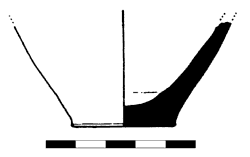 Cup from Ag. Marina © Sphakia Survey |
At Ag. Marina there is very little table ware. What we have collected is almost all unpainted.
2. Cooking
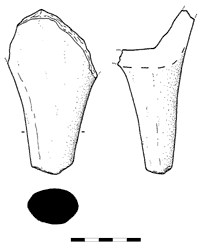 Tripod cooking pot from Ag. Marina © Sphakia Survey |
Cooking wares are well represented, chiefly by fragments of tripod cooking pots.
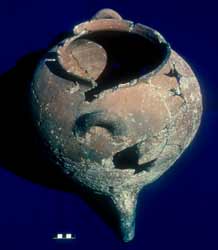 Tripod cooking pot from Kommos. © Robert Vincent Jr |
They are similar in design to the one from Kommos that we saw earlier. (Refer to Unit 3 Session 1 Lesson 3.)
3. Storage/Transport
 Pithos from Ag. Marina © Sphakia Survey |
Fragments of heavy, thick-walled storage vessels (pithoi) have also been preserved.
Remember the whole vessels that we saw at Knossos in Unit 3 Session 1 Lesson 3.
4. Special
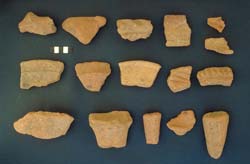 Ag. Marina scatter 8: Minoan sherd assemblage, including potter’s discs, vessels with interior incision, and bull figurines (top left). © Sphakia Survey |
Ag. Marina produced four different types of special ceramic objects: bull figurines; potter’s discs and bats; and four vessels with interior incisions.
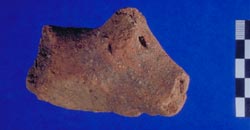 Bull Figurine Head from Ag. Marina. © Sphakia Survey |
One concentration (no. 8) produced examples of each type.
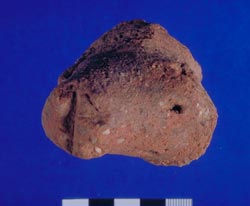 Bull Figurine Head from Ag. Marina. © Sphakia Survey |
We saw before in Unit 3 (Unit 3 Session 1 Lesson 3) that bulls had a special significance (whatever it was!) for the Minoans.
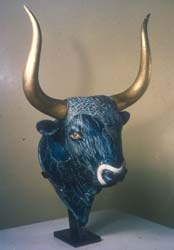 Height: 30.6 cm excluding horns. © Ministry of Culture Archaeological Receipts Fund |
This bull figurine is small, and made of baked clay, so it is very different from the large serpentine bull’s head with gilded horns from Knossos. But it might well have had a similar meaning.
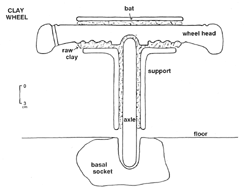 Minoan potter’s wheel reconstruction drawing. |
Several potter’s discs and bats were found at Ag. Marina. Both were used in pottery production using a wheel. The disc or wheelhead was attached to the axle of the potter’s wheel.
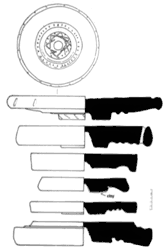 Minoan wheelheads (type 3c) reconstruction drawings. |
The bat was then centred on the disc, and kept in place with a layer of clay. Pots were then made by centering clay on the bat, and drawing the clay up into the desired shape while the wheel was turning. The reconstruction drawing shows how the potter’s wheel was put together.
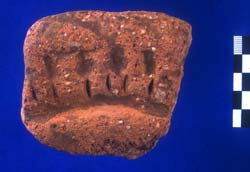 Potter’s disc from Ag. Marina. © Sphakia Survey |
The next set of diagrams show what the discs looked like, with one seen from below, and the other six seen in profile.
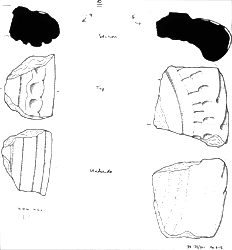 Potter’s discs drawings from Ag. Marina. © Sphakia Survey |
The photograph shows one side of a potter’s disc fragment from Ag. Marina, and the drawing on the right shows both sides and a profile.
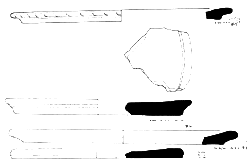 Potter’s bats drawings from Ag. Marina. © Sphakia Survey |
The next set of drawings shows some of the bats from Ag. Marina.
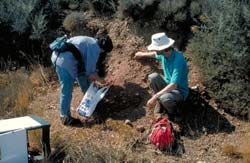 Jennifer Moody pointing at clay terra rossa with stratified Prehistoric bodysherd; Simon Price pointing at Mixed Metamorphic sherd. © Sphakia Survey |
The local earth, the terra rossa found in many parts of Sphakia, could have been used to make many of the pots found at Ag. Marina.
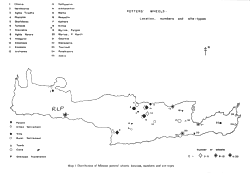 Distribution map of Minoan potter’s wheels. |
The map giving the distribution of Minoan potter’s wheels in Crete shows that there are relatively few production sites. Ag. Marina therefore joins a select group of places where Minoan pottery was made.
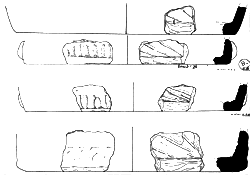 Vessels with internal scoring, drawings of bases, from Ag. Marina. © Sphakia Survey |
The last type of 'special' pottery consists of vessels with interior incisions. Lines were incised inside the vessel before it was fired in a kiln, usually in a diagonal or diamond pattern.
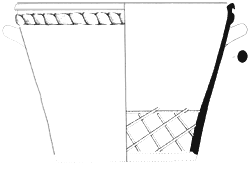 Vessels with internal scoring, from Kommos. © Princeton University Press |
The Ag. Marina fragments are mostly from the lowest part of the vessel. Fortunately, there are less fragmentary examples from other sites, like this one from Kommos.
What were they used for? We don’t know. The vessels are one of the mysteries of Crete!
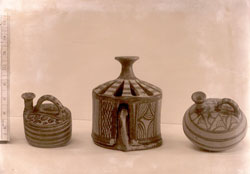 Incense cup and cover. H. 0.126 (inv. ae.282). Stirrup jars H. 0.079, H. 0.067. Courtesy of the Ashmolean Museum, University of Oxford. |
There was very little Prehistoric material known from this area before the work of the Sphakia Survey. Arthur Evans acquired through a friend some Minoan vessels from somewhere in this area; they are now in the Ashmolean Museum, Oxford.
We do not know exactly where these whole vessels came from. In other words, we don’t have their exact context. What can these pots add to our view of the Prehistoric period in this area? Please post your thoughts to the Discussion Forum.